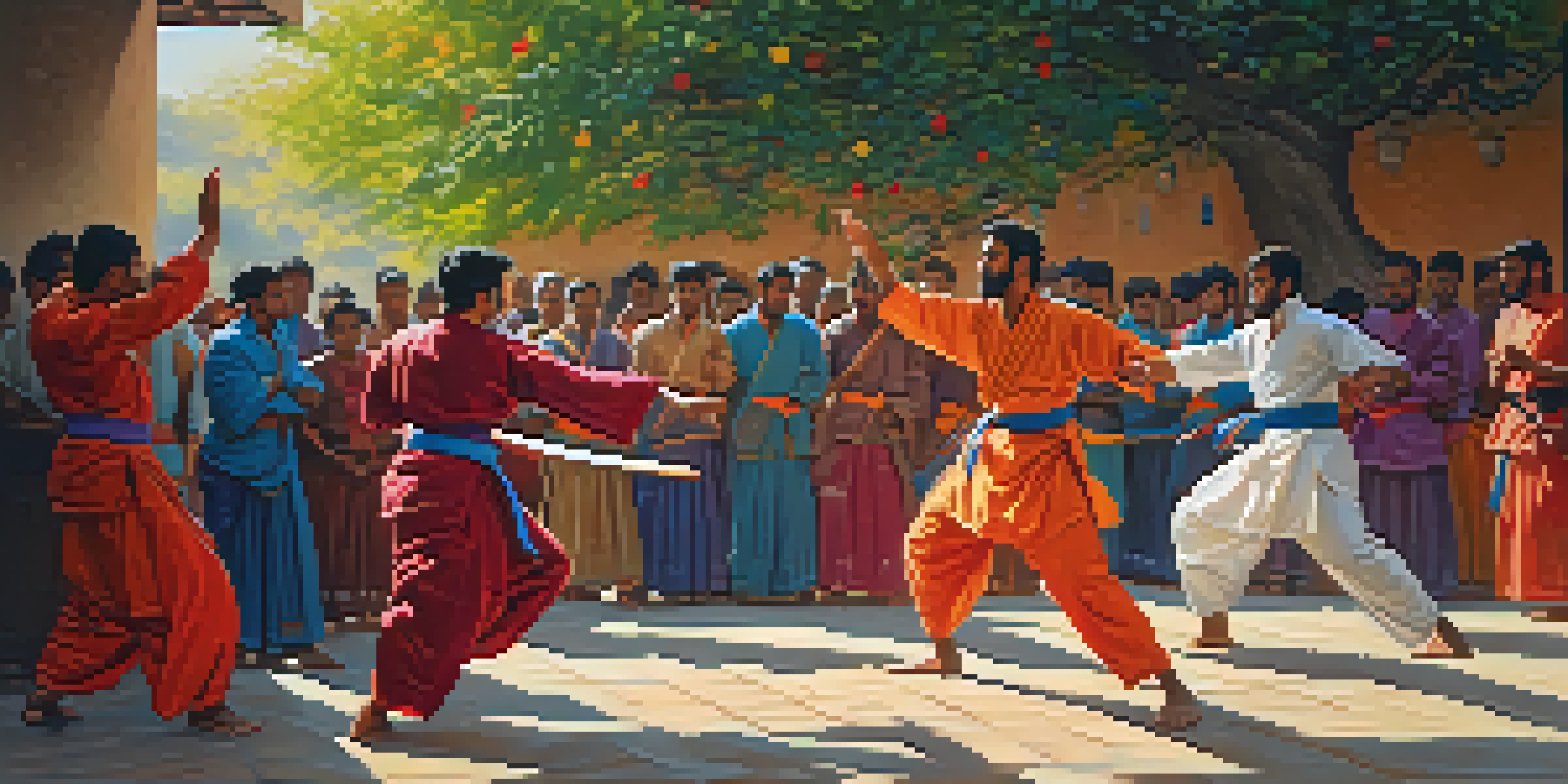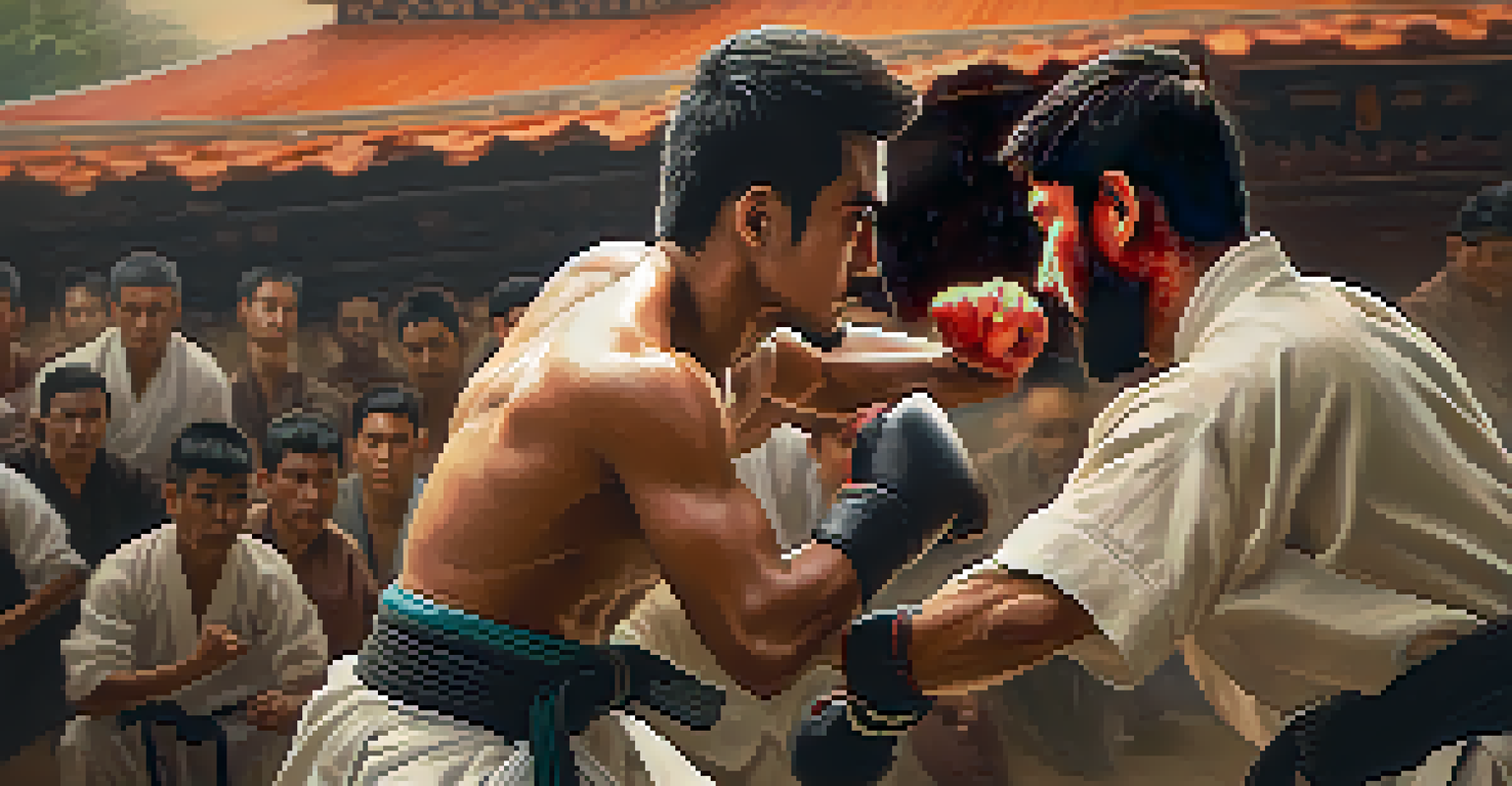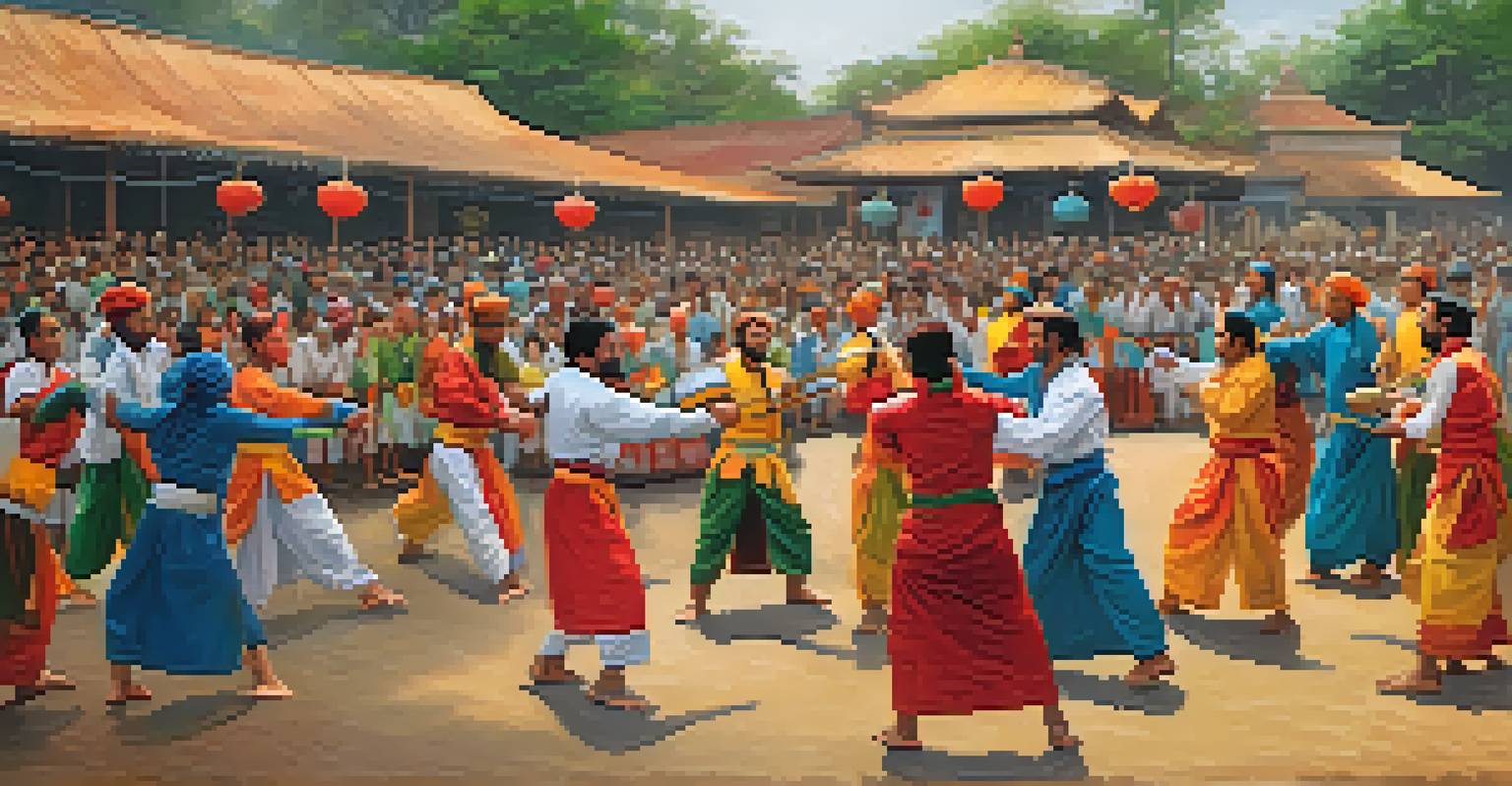Chowk Sparring: The Art of Traditional Indian Martial Arts

Understanding Chowk Sparring: A Martial Art Form
Chowk Sparring is a traditional Indian martial art that emphasizes agility, precision, and strategy. Originating from the cultural tapestry of India, it showcases the rich heritage of combat techniques passed down through generations. This practice is not just about physical prowess but also about mental discipline and respect for one’s opponent.
Martial arts is not about fighting; it's about building character.
The term 'Chowk' refers to the square space where practitioners often train and spar. It symbolizes a communal gathering, where individuals come together to learn and grow in their martial abilities. This setting encourages a spirit of camaraderie among fighters, which is a core value in many traditional Indian arts.
As you delve deeper into Chowk Sparring, you'll find it combines various elements like footwork, striking, and grappling, all designed to create a well-rounded martial artist. It's a fascinating blend of skill and technique that invites enthusiasts to not only practice but also appreciate the art form's cultural significance.
Historical Roots of Chowk Sparring in India
The history of Chowk Sparring can be traced back to ancient India, where martial arts played a crucial role in military training. Warriors practiced these techniques not just for combat but also to prepare for the mental challenges of battle. Various texts and teachings from this era emphasize the importance of martial discipline, which remains relevant in Chowk Sparring today.

Over the centuries, Chowk Sparring has evolved, absorbing influences from different regions and cultures. This adaptability has allowed it to thrive, even as modern combat sports have gained popularity. The techniques taught in Chowk Sparring today reflect a blend of tradition and contemporary understanding of martial arts.
Cultural Heritage of Chowk Sparring
Chowk Sparring is a traditional Indian martial art that combines physical prowess with mental discipline, reflecting the rich cultural heritage of India.
Moreover, the art form has been preserved through oral traditions and community gatherings, ensuring that its values and techniques are passed on. Each generation of practitioners contributes to the rich narrative of Chowk Sparring, making it a living tradition that honors its past while looking towards the future.
Techniques and Skills in Chowk Sparring
Chowk Sparring emphasizes a variety of techniques that enhance both offensive and defensive skills. Practitioners learn to execute strikes, blocks, and counters, all while maintaining balance and control. This versatility is crucial, as it prepares fighters for real-life encounters where adaptability is key.
The journey of a thousand miles begins with one step.
Footwork is another essential component of Chowk Sparring. The ability to move swiftly and fluidly within the sparring area allows practitioners to evade attacks and create opportunities for counter-strikes. Imagine a dancer gracefully navigating a stage; this is akin to how a Chowk fighter maneuvers during sparring.
Furthermore, practitioners engage in drills and sparring sessions that not only refine their techniques but also build their confidence. These sessions foster a supportive environment where fighters learn from each other, encouraging growth and camaraderie. It’s this sense of community that enriches the learning experience.
The Role of Mental Discipline in Chowk Sparring
Mental discipline is a cornerstone of Chowk Sparring, shaping not only fighters’ techniques but their character as well. Practitioners learn to focus their minds, cultivating a sense of calm even in the heat of sparring. This mental fortitude translates into other areas of life, enhancing decision-making and resilience.
Visualization is one technique often employed in training. Practitioners might visualize their movements and strategies before executing them, allowing for greater precision during actual sparring. This mental rehearsal is akin to an actor preparing for a performance, ensuring they are ready to shine when the moment arrives.
Mental Discipline's Key Role
Practitioners of Chowk Sparring develop mental discipline that enhances focus, decision-making, and resilience in both martial arts and everyday life.
Moreover, respect for opponents is ingrained in the practice. Fighters are encouraged to view their sparring partners not just as rivals but as collaborators in the journey of martial arts. This mindset fosters an environment of mutual respect and learning, essential for personal growth and mastery of the art.
Cultural Significance of Chowk Sparring
Chowk Sparring is steeped in cultural significance, reflecting the values and philosophies of Indian society. It often incorporates elements of traditional music and dance, connecting the physicality of martial arts with the rich artistic expressions of India. This cultural fusion makes Chowk Sparring not just a sport but a celebration of heritage.
Community events and festivals often feature Chowk Sparring, showcasing the art form to a wider audience. These gatherings serve as an opportunity for practitioners to demonstrate their skills and share their passion with others. It's a vibrant way to keep traditions alive and inspire future generations to participate.
Additionally, Chowk Sparring emphasizes the importance of honor and integrity in martial arts. Practitioners are taught to uphold these values, both on and off the sparring mat. This commitment to cultural integrity reinforces the idea that martial arts is as much about personal development as it is about physical skill.
Challenges Facing Chowk Sparring Today
Like many traditional practices, Chowk Sparring faces challenges in a rapidly modernizing world. The rise of contemporary martial arts and sports can overshadow traditional forms, making it difficult for Chowk Sparring to attract new practitioners. However, this also presents an opportunity to reintroduce its unique benefits and cultural richness.
Maintaining the authenticity of Chowk Sparring while embracing modern training methodologies is another challenge. Practitioners and instructors must find a balance between preserving tradition and integrating effective techniques that can enhance training outcomes. This evolution is crucial for keeping the art relevant and engaging for new generations.
Challenges and Future Prospects
While facing challenges from modern sports, Chowk Sparring is experiencing a resurgence as new generations seek to connect with traditional martial arts.
Despite these challenges, there is a growing interest in traditional martial arts as people seek holistic practices that promote physical and mental well-being. With dedicated practitioners and advocates, Chowk Sparring has the potential to flourish, bridging the gap between tradition and modernity.
The Future of Chowk Sparring: Preserving Tradition
The future of Chowk Sparring looks promising, driven by a renewed interest in traditional martial arts. Schools and training centers are beginning to incorporate Chowk Sparring into their curricula, introducing it to a younger audience eager to explore their cultural heritage. This resurgence is vital for ensuring the art form's survival and growth.
Online platforms and social media have also played a significant role in promoting Chowk Sparring. Practitioners can share videos, tutorials, and experiences, building a global community that transcends geographical boundaries. This digital engagement fosters a sense of belonging and encourages knowledge exchange among martial artists worldwide.

Ultimately, the preservation of Chowk Sparring relies on the passion and dedication of its practitioners. By fostering a love for the art and its cultural significance, the next generation can carry forward this rich tradition, ensuring that Chowk Sparring remains a vibrant part of India’s martial arts landscape for years to come.